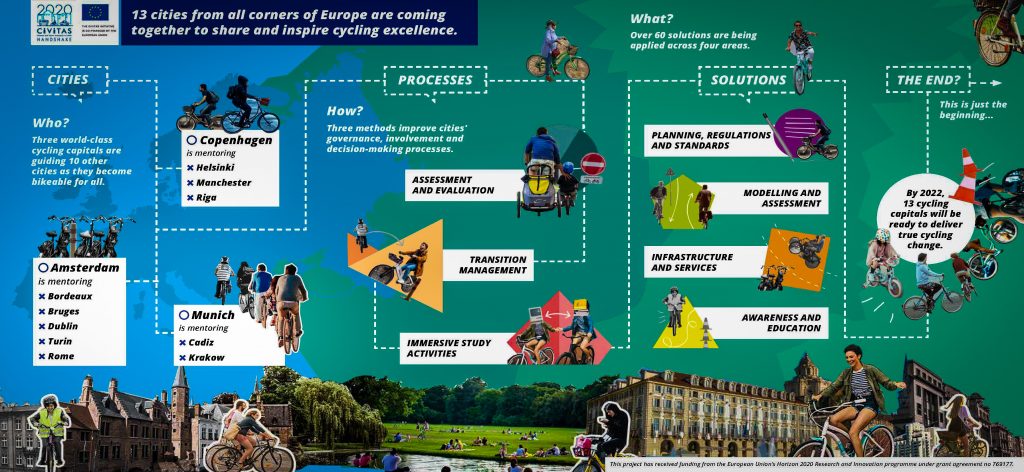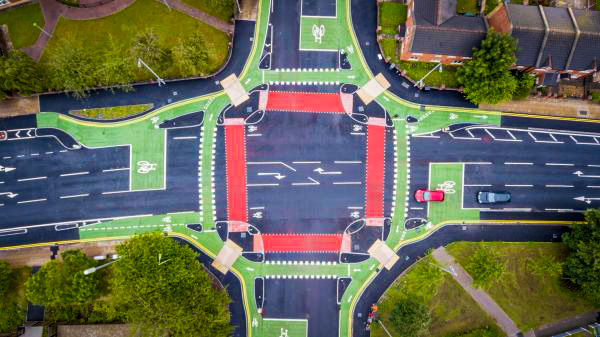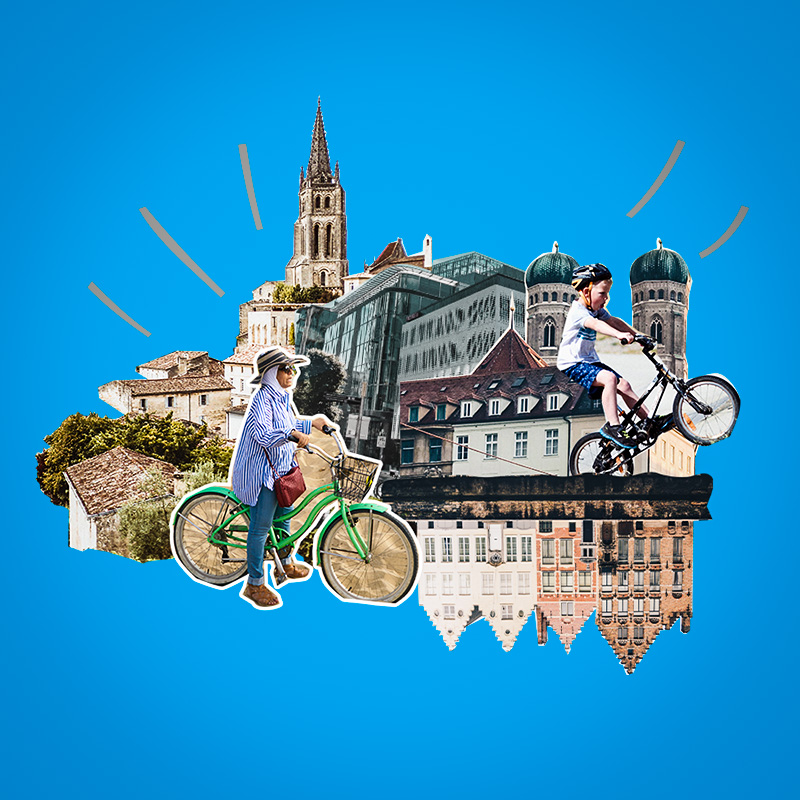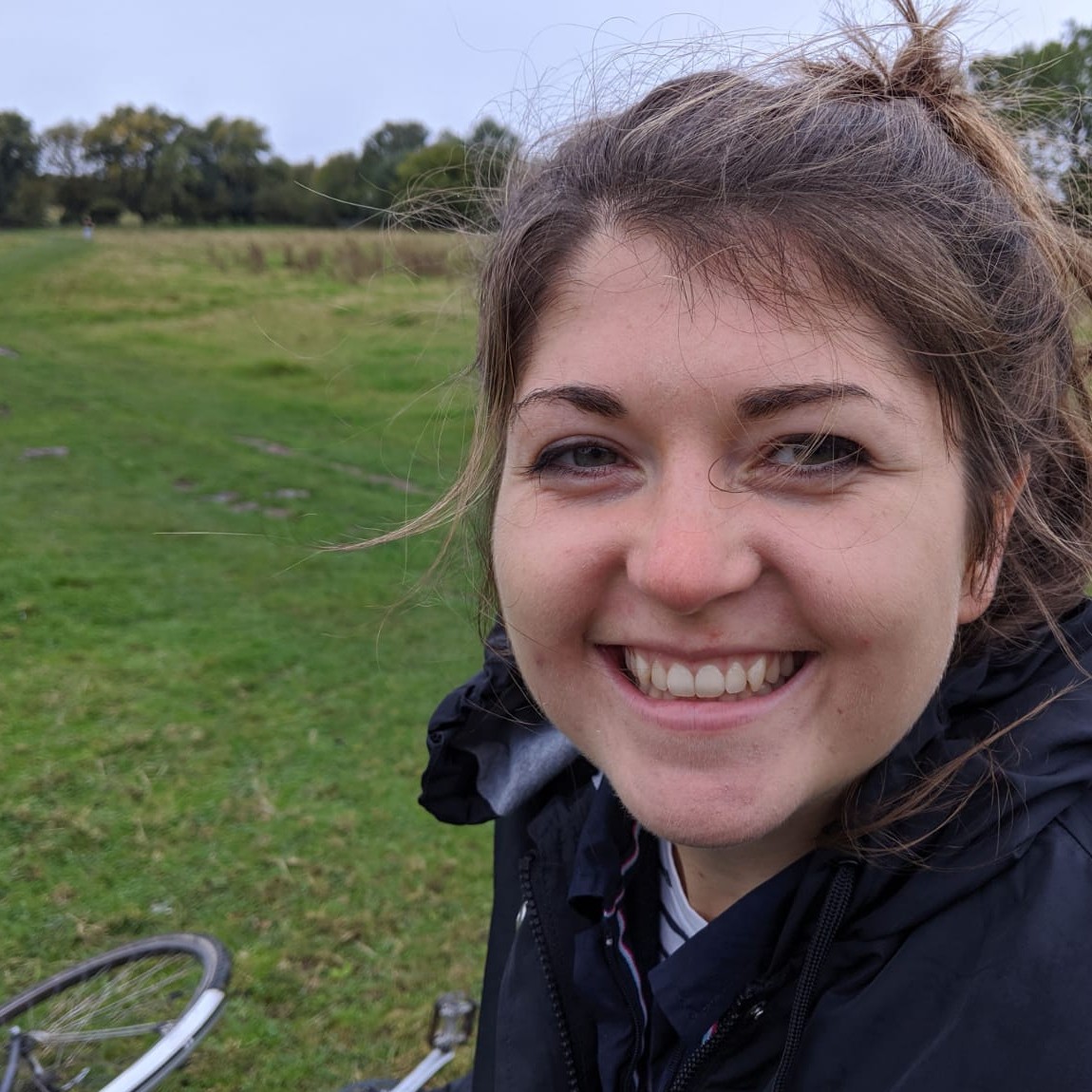‘Handshake’ is currently the biggest European Union project on cycling, combining thirteen cities and a budget of nearly five million euros. We spoke to the project coordinator, Mario Gualdi, to get a first-hand account.
What’s the Aim of Handshake?
“The starting idea is bringing together people that are doing similar things, in different cultures and socio-economic contexts,” says Mario. Running from 2018 – 2022, the project aims to pair ten ‘future cycling capitals’ with one of the three ‘cycling capitals’. The mentor city then advises and inspires the developing city in their cycling plans.
“Cities make available what they know; there’s no hidden agenda, they’re really just trying to help,” explains Mario. “We’re bringing together these elements of mentoring and helping each other with the concept of transition management.”
Rather than setting deadlines and plans, the project aims to accelerate and improve the cities’ existing cycling agenda. “We don’t dictate the pace of planning or the vision… we work with what cities already have and try to empower them,” explains Mario.
How Were the Participating Cities Picked?
“We started by trying to identify the cities that could really act as a source of inspiration – quite clearly, we asked Amsterdam and Copenhagen,” says Mario.
What is interesting is that neither Amsterdam nor Copenhagen had ever jointly worked on a cycling project before. “It was very rewarding that they both accepted; this was an occasion to break the ice and develop cycling solutions together,” he states.
The third lighthouse city chosen was Munich, a city “heralded as the communication champion” says Mario. Over the last 20 years, Munich has consistently marketed cycling and behaviour campaigns – something which is needed to create a cycling culture.
With three mentor cities chosen, ten future cycling cities then had to be picked. “We were looking for cities that really demonstrated the willingness to change, even if they started from completely different walks of life,” says Mario. “In Cádiz they barely knew what a bike was, whereas Bruges its already quite advanced. But we consider them all future cycling capitals.”
Along with Cádiz and Bruges, the other future cycling capitals are Riga, Helsinki, Manchester, Bordeaux, Krakow, Turin, Rome and Dublin.
What Strategies Does Handshake Use?
The project assists the cities in any stage of delivery – from planning and implementation to monitoring. Combining experience and knowledge from all the cities involved, there are over sixty measures which the cities can draw from.

The measures used depends on the city’s stage of development. “Some cities are already focused on fine tuning specific segments of their cycling network … other cities are more at a stage of saying ‘how do I actually convince my people?’” explains Mario.
One of the particularly novel techniques has been the use of ‘transition arenas’ and ‘immersive study tours’. This involves a group of stakeholders in each city meeting regularly to discuss cycling policies, and then undertaking a five-day visit to their mentoring cycle capital. For more insight into this trending technique, read our in-depth article here.
Evaluation has also been a key part of the project, notably through ‘bikeconomics’, a methodology to determine the benefits of cycling. “One of the misconceptions that mars urban cycling is that it doesn’t have any economic impact”, says Mario. “But in reality, it unleashes huge economic returns, not just in terms of externalities but major social and environmental gains”. By evidencing these benefits, the project can then use them as a communication tool to convince politicians and citizens.
Stories of the Cities’ Cycling Changes so Far
All of the thirteen cities have been pursuing new cycling policies and ideas during the project. To give you a flavour of some of them, we’ve outlined a few highlights below.
Greater Manchester opened the UK’s first ever ‘CYCLOPS’ junction, which separates cyclists, pedestrians and motorised traffic through protected signals. This was part of the city’s ‘Bee Network’, which aims to join 800 miles of cycling routes.
Chris Boardman, the British olympic cyclist, has figure-headed the network which has added a welcome celebrity spin.

Helsinki city council approved it’s Bicycle Action Plan 2022-2015 which outlines a comprehensive and maintained cycling network. This was thanks, in part, to the “intensive interaction that Helsinki has had with their mention, Copenhagen. They worked a lot together in drafting this plan – it’s an example of real cooperation,” says Mario.
A new bicycle and pedestrian bridge was built in Dublin over the Royal Canal. Prior to the bridge, cyclists had previously had to mixed with motorised traffic. In Krakow, free bike services checks were organised across the city between August and October 2020, repairing 530 bikes in total.
However, despite these positive examples of changes made, many of the original proposals have been affected by the Covid-19 pandemic.
How Has Coronavirus Affected Handshake?
Even the project’s name, ‘Handshake’, has been affected by Covid-19. No longer recognised as a symbol of cooperation but of contamination. “The projects are suffering from Covid, because they rely greatly on the physical interaction between cities and people,” says Mario.
Particularly challenging has been the prolonged postponement of the ‘immersive study tours’ where key stakeholders visit their mentoring city.
“It was supposed to be a ‘shock moment’ that would ignite change in the cities… but everything was dismantled,” laments Mario.
That said, new avenues and cycling polices have come to light during the pandemic. Rome, for instance, has gained European recognition for its cycling measures in response to Covid-19. Setting up 150km of cycling routes during the pandemic, the city has emphasised that these are not temporary but transitory lanes intent on becoming permanent.
“Cycling is an area which usually gathers people that are very passionate, so even if they can’t see each other, they’re are working greatly with all the different virtual tools they have,” says Mario. Overall, he sees an acceleration in some areas to compensate the delay of other plans.
In a Nutshell…
Despite not being able to shake hands, the Handshake project has not lost momentum nor progress. As the thirteen participating cities navigate cycling’s relationship with Covid, the project offers a supportive knowledge-sharing network. From our glimpse behind the scenes so far, it will be exciting to see how the Handshake Project’s finale plays out.


